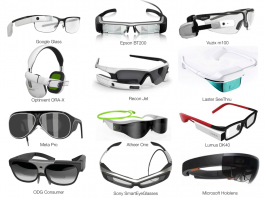AUGMENTED REALITY GLASSES
6 February 2018

Vaunt from Intel is the first pair of smart eyeglasses that doesn’t look ridiculous. It uses a very low-powered laser.
Looking back it will seem weird that a lot of daily life objects did their job without a digital component in the early 21st century. Like your jacket, your shoes or your glasses. Well in fact you can buy all of these including constant internet connectivity, ai-powered conversational interfaces or sensors that send data back to the mothership or get their data from servers around the world but it is just not what everybody does these days.
2020, 2022, 2023
Glasses still tend to be dumb. Otherwise they look like frightening tech-stuff, like immature science fiction prop gone wrong. Until now. Well at least i must admit that the Vaunt prototype by Intel looks neat. I would wear these glasses and i would be very pleased to be guided through the city using the discreet visual interface making use of a laser projection into the eye (VCSEL) because the Vaunt does not repeat the mistakes every single manufacturer has repeated until now: Stuff everything you can into a pair of glasses.

It is still very early days. Most so called experts are pretty sure that it will take several years before augmented reality glasses hit the consumer market (*): Bloomberg reported in November that Apple was targeting a 2020 release date for its first set of AR glasses. Goldman Sachs thinks a release in 2022 or 2023 is more likely for Apple’s smartglasses.

We are actually already in the process of transitioning from smartphones to smartglasses without really noticing it. There was this chart in Alvin Wang Graylin´s presentation at EmTech Asia that nicely made the point. Oh, Graylin by the way is China President: #Vive / Vice-Chair: Industry of VR Alliance #IVRA.
There are a hell lot of smart glasses around these days (2015 / 2016 / 2018). Most of them look like useless tech toys and looking back this is exactly how they will be characterized. We will laugh about their limitations just like we laugh about all these crazy phones before 2007. Looking forward to the coffee table book that shows the best AR glasses before 2025, with academic essays telling us about life back in the days.

Actually a lot of what we need is just right here. It is just to big, not well-combined or not executed right. If you look around you will already find devices with a lot of sensors „that can track brainwaves, eye movement, facial expressions, 3-axis accelerometer, gyroscope, magnetometer, and pressure sensors, real-time biofeedback, brain training exercises and meditation“ etc. like the Lockdown Focus in collaboration with Smith Optics: A pair of brain-sensing glasses and/or sunglasses aimed at improving your performance under pressure. Thank you very much.

I just saw this tweet from China 19 hours ago: This is not Google Glass, but facial recognition glass connected to Chinese police database. Deployed to a Zhengzhou railway station 5 days ago, it has detected at least 7 fugitives and 26 fake ID holders. #surveillance.
These abstract make up tipps to hide from surveillance are 8 years old.
